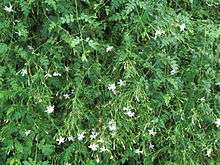Jasminum grandiflorum
| Royal jasmine Spanish jasmine Catalonian jasmine | |
|---|---|
| Scientific classification | |
| Kingdom: | Plantae |
| (unranked): | Angiosperms |
| (unranked): | Eudicots |
| (unranked): | Asterids |
| Order: | Lamiales |
| Family: | Oleaceae |
| Genus: | Jasminum |
| Species: | J. grandiflorum |
| Binomial name | |
| Jasminum grandiflorum L. | |
Jasminum grandiflorum, also known variously as the Spanish jasmine, Royal jasmine, Catalonian jasmine, among others[1] (chameli in Urdu) is a species of jasmine native to South Asia, the Arabian peninsula (Oman, Saudi Arabia), Northeast Africa (Eritrea, Ethiopia, Djibouti, Somalia, Sudan), the African Great Lakes (Kenya, Uganda, Rwanda), and the Yunnan and Sichuan regions of China. The species is widely cultivated and is reportedly naturalized in République de Guinée, the Maldive Islands, Mauritius, Réunion, Java, the Cook Islands, Chiapas, Central America, and much of the West Indies.[2]
Description
It is a scrambling deciduous shrub growing to 2–4 m tall. The leaves are opposite, 5–12 cm long, pinnate with 5–11 leaflets. The flowers are produced in open cymes, the individual flowers are white having corolla with a basal tube 13–25 mm long and five lobes 13–22 mm long.[3][4] The flower's fragrance is unique and sweet.
Subspecies
Two subspecies are recognized:[2]
- Jasminum grandiflorum subsp. floribundum (R.Br. ex Fresen.) P.S.Green[5] (syn., Jasminum floribundum R. Br. ex Fresen.)[6] - African and Arabian portions of natural range
- Jasminum grandiflorum subsp. grandiflorum - South Asian plants as well as cultivars and naturalized populations
Uses
In India, its leaves are widely used as an Ayurvedic herbal medicine and its flowers are used to adorn the coiffure of women. In Pakistan, it grows wild in the Salt Range and Rawalpindi District at 500–1500 m altitude.[3] It is closely related to, and sometimes treated as merely a form of, Jasminum officinale.[7] The plant is known as "saman pichcha" or "pichcha" in Sri Lanka. Buddhist and Hindu temples use these flowers in abundance.
It is widely cultivated as an ornamental plant in warm temperate and subtropical regions.
By method of solvent extraction the Jasmine flowers are converted into Jasmine Concrete and Jasmine Oleoresin (sold as Jasmine Absolute). Both products have a huge demand in the fragrance industry.
Methyl jasmonate isolated from the jasmine oil of Jasinum gradiflorum led to the discovery of the molecular structure of the jasmonate plant hormones.[8]

References
- ↑ ARS-GRIN.gov article
- 1 2 Kew World Checklist of Selected Plant Families, Jasminum grandiflorum
- 1 2 Flora of Pakistan: Jasminum grandiflorum
- ↑ Flora of China v 15 p 313: Jasminum grandiflorum
- ↑ Green, Peter Shaw. 1986. Kew Bulletin 41: 414.
- ↑ Fresenius, Johann Baptist Georg Wolfgang. 1837. Museum Senckenbergianum. Abhandlungen aus dem Gebiete der Beschreibenden Naturforschenden Gesellschaft in Frankfurt am Main 2: 16.
- ↑ Huxley, A., ed. (1992). New RHS Dictionary of Gardening. Macmillan ISBN 0-333-47494-5.
- ↑ Demole E (1962). "Isolement et détermination de la structure du jasmonate de méthyle, constituant odorant caractéristique de l'essence de jasminIsolement et détermination de la structure du jasmonate de méthyle, constituant odorant caractéristique de l'essence de jasmin". Helv Chim Acta. 45: 675–85. doi:10.1002/hlca.19620450233.
| Wikispecies has information related to: Jasminum grandiflorum |
External links
- http://www.researchgate.net/publication/215517134_Jasminum_grandiflorum_Linn_(Chameli)_Ethnobotany_Phytochemistry_and_Pharmacology__A_review
- http://www.backyardgardener.com/plantname/pda_de7b.html
- http://www.ageless.co.za/jasmine.html
- Umamaheswari, M; Asokkumar, K; Rathidevi, R; Sivashanmugam, A. T.; Subhadradevi, V; Ravi, T. K. (2007). "Antiulcer and in vitro antioxidant activities of Jasminum grandiflorum L". Journal of Ethnopharmacology. 110 (3): 464–70. doi:10.1016/j.jep.2006.10.017. PMID 17125945.
- Somanadhan, B; Smitt, U. W.; George, V; Pushpangadan, P; Rajasekharan, S; Duus, J. O.; Nyman, U; Olsen, C. E.; Jaroszewski, J. W. (1998). "Angiotensin converting enzyme (ACE) inhibitors from Jasminum azoricum and Jasminum grandiflorum". Planta Medica. 64 (3): 246–50. doi:10.1055/s-2006-957419. PMID 9581523.